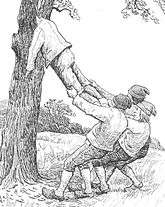Molbo story
A Molbo story is a Danish folktale about the people of Mols, who live in eastern Jutland near the town of Ebeltoft.[1] In these tales the Molboes are portrayed as a simple folk, who act foolishly while attempting to be wise.[2]
History

Molbohistorier (Molbo stories) were handed down by generations of Danes before finally appearing in print. Christian Elovius Mangor,[3] who by permission of the Danish monarch Christian VII had started a printing press in Viborg, published the first collection, Tales of the well-known Molboes’ wise and brave actions, in 1771.[4] A second edition followed in 1780.[5] Over the years Molbo stories have been published in books for adults and children in several languages, including Danish,[6] Norwegian [7] and English.[8] Similar narratives are found in other cultures. England, for instance, has "Lazy Jack" [9] and "The Wise Men Of Gotham." [10] In Finland there are stories about the people of Holmola (Hölmöläiset).[11][12]
In 1898 the operetta "Molboerne" (The People Of Mols) by composer Olfert Jespersen and lyricist Herman Petersen premiered in Copenhagen. The work not only had a memorable score but numerous references to such Molbo stories as “The Stork In The Corn” and “Leg-Sorting”.[13]
Norway, which for nearly three centuries was part of the kingdom of Denmark-Norway, received many cultural influences from Denmark. Consequently, Molbo stories are known in both Denmark and Norway, and the word “Molbo” is used in both countries as a term of disparagement. The expression "Molbo politics" is prohibited when speaking from the rostrum in Norway's parliament.[14]
The Headless Man

- The Molboes have a long way to the forest so they must rise early to collect wood. One morning some of them drove to the forest to bring home a tree they had bought. But on the way the one who drove first happened to lose his axe, and when the others saw that, they thought he threw it away on purpose, so they threw away their axes as well. Now, as they stood in the forest, they had nothing with which to chop, they didn't know what to do at all, and they certainly didn't want to come home empty-handed. Finally one of them had the brilliant idea to pull the tree down; but as they hadn't brought a rope, one of them had to climb the tree and lay his head in the cleavage between two branches then the others were to pull his legs until the tree yielded. Very well, they pulled and they pulled, and eventually they all fell backwards, including the chap they had been pulling, only he had no head. This they couldn't fathom, they went searching and searching, but no, they didn't find the head, because it was stuck in the tree. Well, that couldn't be helped, now it was time to return home. And so they laid the headless man in the wagon and took him home to his wife and asked if she was sure that her husband had brought his head when he left home this morning. "I can't remember that right now!", said the wife; but then she thought for a while: "Oh yes, he did bring his head!" she said. "He ate cabbage with it this morning before he left." [15]
See also
References
- ↑ Old stories from Mols, illustrated by Axel Mathiesen, (Ebeltoft, Denmark: Kaj Elle,1952)
- ↑ Those foolish Molboes, by Lillian Bason and Margot Tomes, (New York: Coward, McCann and Geoghegan, 1977)
- ↑ Christian Elovius Mangor runeberg.org. Retrieved: May 25, 2014.
- ↑ C. E. Mangor denstoredanske.dk. Retrieved: October 12, 2014.
- ↑ Beretning om de vidtbekiendte Molboers vise Gierninger og tapre Bedrifter, 2. Opl., forøget og forbedret, (Viborg, Danmark, 1780)
- ↑ Molbo- og Aggerbohistorier samt andre dermed beslægtede Fortællinger / 2. Samling by Evald Tang Kristensen, (Århus, Denmark: Forfatterens Forlag, 1903)
- ↑ Molbohistorier, gamle og nye, by Oskar Braaten, (Oslo: Aschehoug, 1941)
- ↑ Old stories from Denmark, illustrated by Poul Lundsgaard, (Ebeltoft, Denmark: Kaj Elle,1967)
- ↑ Lazy Jack authorama.com. Retrieved: May 25, 2014.
- ↑ The Wise Fools Of Gotham sacred-texts.com.com. Retrieved: May 25, 2014.
- ↑ "The Holmolaiset Build A House" google.com. Retrieved: May 25, 2014.
- ↑ Tales from a Finnish tupa, by James Cloyd Bowman and Margery Bianco, (Minneapolis: University of Minnesota Press, 2009) pp. 220-230.
- ↑ Molboerne (eventyrspil)] mono.net. Retrieved: May 25, 2014.
- ↑ Molbopolitikk Oslo Dagbladet 28. februar 2014
- ↑ A priceless Molbo-story by Ariane Schjelderup and Øyvind Olsholt buf.no. Retrieved: May 25, 2014.
External links
- Molbohistorier 01
- Molbohistorier 02
- Molbohistorier 03
- The Molbo Column
- Hayseeds And Bumpkins
- The Molboes and the Hen
- Book
- Images
- Streaming audio
- Videos